Social skills for an autistic child can be so frustrating at times! It can be frustrating for you and it can be so frustrating for your child. I want to make things a little less frustrating for you and your child as you learn what, when, and how to teach social skills.
All kids with autism have some difficulties with social skills
According to the Autism DSM 5, one of the criteria for a diagnosis of autism is a deficit in Social Communication and Interaction. So, it’s fair to say that all kids with autism have some difficulties with social skills. However, it is not fair to say that all children with autism have the same difficulties with social skills.
Every child is different, which is why it’s important that we individualize how we teach each child. That’s where it gets a little complicated for me in writing these posts. I want to individualize things for you, but it’s hard to do in this format. I will do my best to give you information that will be helpful, but I really wish I could get to know you and your child so I could help you even more!
What social skills should you teach a child with autism?
I’ll give you a short list of some of the important social skills that kids should start to learn at an early age. You can choose a few skills you’d like your child to work on, however realize that some skills have prerequisite skills. For example, if your child doesn’t yet participate in parallel play, then you might not want to focus on turn taking and sharing yet.
- Joint attention
- Engage in play
- Allow others to join in the play
- Initiate play
- Parallel play
- Pretend play
- Try new things
- Attend to an activity
- Participate in group activities
- Complete a task before moving on to something new
- Imitate simple actions spontaneously
- Follows directions
- Accepts “no” for an answer
- Problem solving
- Sharing
- Turn taking
Get Your Free Quick-Start Guide To Autism Early Learning
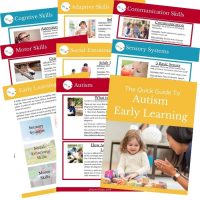
Enter your name and e-mail and you’ll receive your FREE Quick-Start Guide in your inbox shortly. Plus, I’ll send you helpful tips and ideas for working with kids with autism.
You can unsubscribe anytime. For more details, review my Privacy Policy
How to teach a child with autism social skills
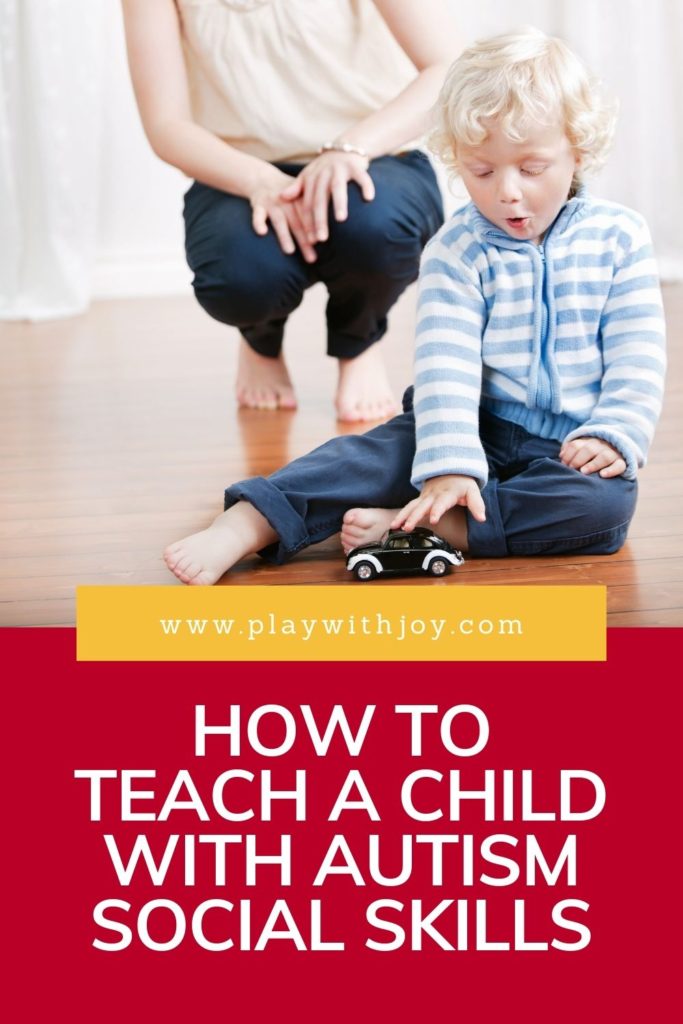
There are a lot of different techniques and activities that you can use to teach social skills. I prefer more play-based and developmental approaches such as The PLAY Project or DIR/Floortime, however I do also use some behavioral approaches as well.
Here’s an example. Let’s say Tommy is 3 years old and he loves to play with cars. He does great playing on his own (independent play), but he struggles with parallel play (playing next to someone with like materials.) Tommy cries when anyone tries to take his cars, and will turn his back to guard his toys or run away with them. How do you teach Tommy how to participate in parallel play if he won’t let you play by him?
You might be tempted to talk to Tommy about sharing his toys, but he’s not ready for that. Teaching him to share at this point would be frustrating for the both of you. It’s important to be playing at the right level with a child to achieve the most growth. If you play too high (sharing) or too low (letting the child play alone the whole time), then you won’t see as much growth.
So, how do you teach Tommy parallel play? Here are a few tips and ideas.
- Start with parallel play with an adult, not a peer. Adults are more predictable than peers.
- If Tommy has a hard time allowing you to play near him, start from further away, then gradually get closer. This may take a few minutes/hours/days. Test the waters, get a little closer and when he protests, back up a little.
- Tommy isn’t going to want to play with you if you always take his toys, so get your own toys! Like I said before, he’s not ready to work on sharing just yet.
- With your own toys, imitate what Tommy is doing.
- Make sound effects
- Narrate what Tommy is doing. Don’t tell him what to do, just narrate what you see him doing. Some kids don’t like having others changing the play, and that’s why they don’t want people to play by them. If you come into a play situation and then change everything up, or tell Tommy what to do, he may not want to play with you.
- Also, don’t ask a lot of questions. If play time turns into quiz time, it’s not as fun.
- If Tommy wants all of your toys, give them to him one at a time. This way you’re getting a lot of back and forth interactions. Then go find more of your own toys.
- If Tommy doesn’t like that you have the same toys as you and always takes them away, you can play with different toys. For example, if he’s playing with cars, get a block and pretend it’s a car. It might not bother him as much that you have a block instead of a car.
- Once Tommy has mastered parallel play with an adult, then you can start working on it with a peer. If you think it will be too hard to do it with a peer the same age as Tommy, start with an older child that you can coach a little.
Social skills are so important in every day life, and we all want to help our kids succeed. If you have a specific social skill you’d like me to focus on, please leave it in the comments.
Get Your Free Quick-Start Guide To Autism Early Learning
Enter your name and e-mail and you’ll receive your FREE Quick-Start Guide in your inbox shortly. Plus, I’ll send you helpful tips and ideas for working with kids with autism.
You can unsubscribe anytime. For more details, review my Privacy Policy
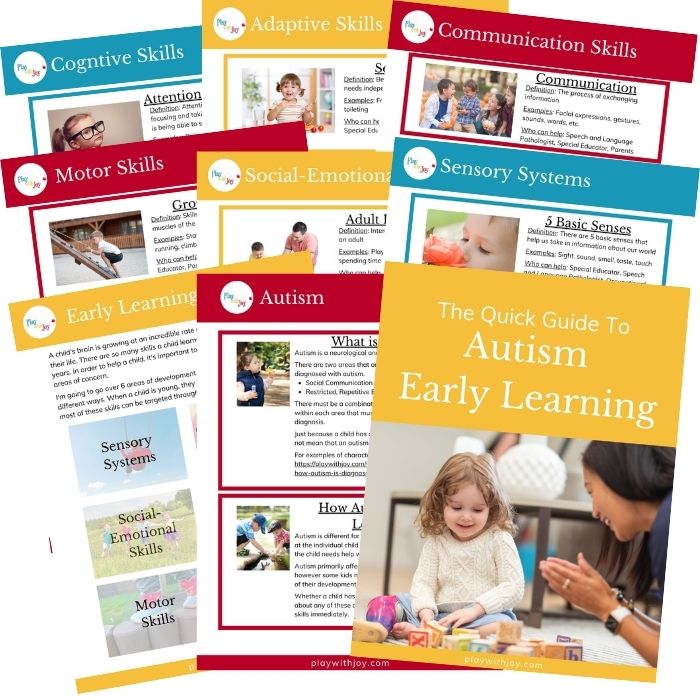
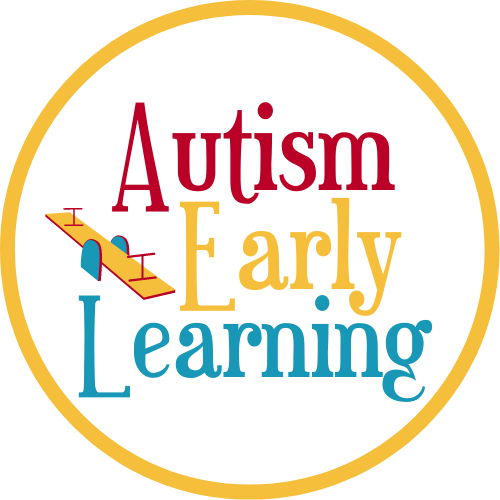


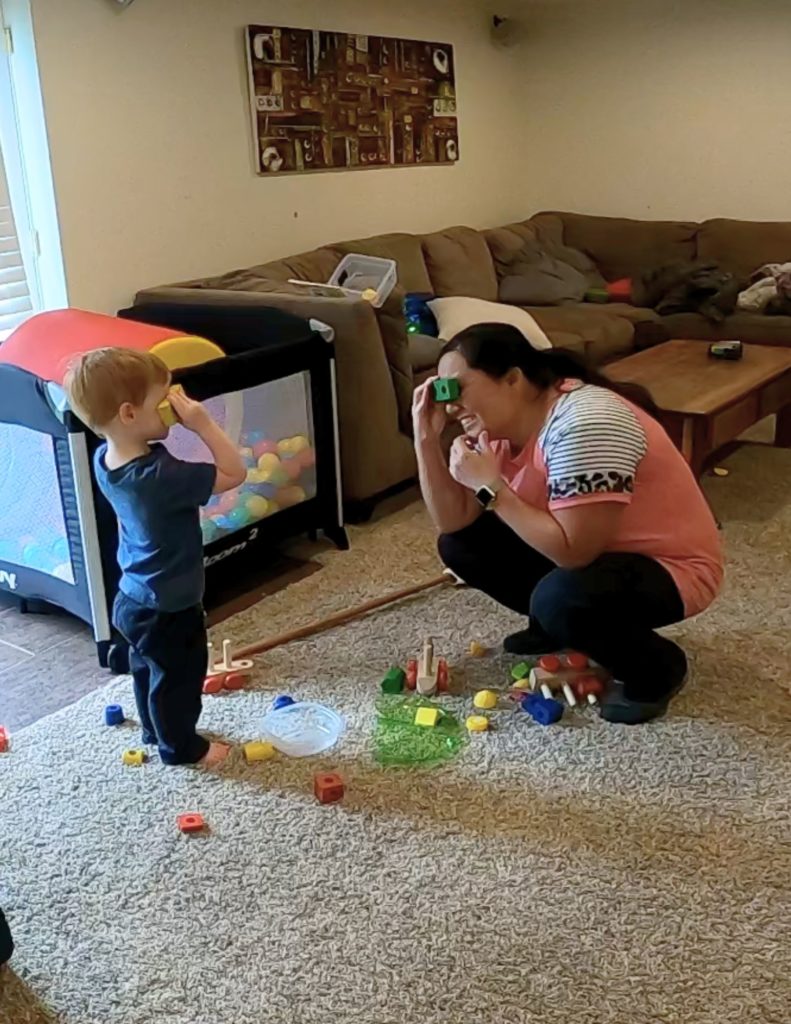


2 thoughts on “How To Teach A Child With Autism: SOCIAL SKILLS”
Your information on the autistic child is excellent. The various suggestions at each level are most helpful!
Thank you! I’m glad the information has been helpful 🙂